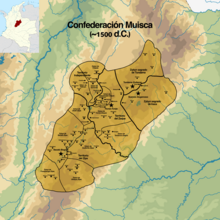| Tisquesusa | |||||
|---|---|---|---|---|---|
| Zipa of Bacatá | |||||
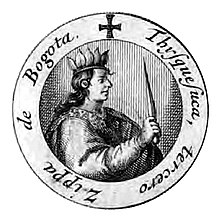 Tisquesusa depicted in 1688 on the cover of Historia general de las conquistas del Nuevo Reyno de Granada by Juan de Castellanos Tisquesusa depicted in 1688 on the cover of Historia general de las conquistas del Nuevo Reyno de Granada by Juan de Castellanos | |||||
| Zipa of Bacatá | |||||
| Reign | 1514 – 1537 | ||||
| Predecessor | Nemequene | ||||
| Successor | Sagipa | ||||
| Nephew | unknown | ||||
| Born | unknown Bacatá, Muisca Confederation | ||||
| Died | 1537 Facatativá, Bacatá, Muisca Confederation | ||||
| Sister | Usaca | ||||
| Issue | Hama (son) Machinza (daughter) | ||||
| |||||
| House | Bacatá | ||||
| Religion | Muisca religion | ||||
Tisquesusa, also spelled Thisquesuza, Thysquesuca or Thisquesusha (referred to in the earliest sources as Bogotá, the Elder) (died Facatativá, 1537) was the fourth and last independent ruler (psihipqua) of Muyquytá, main settlement of the southern Muisca between 1514 and his death in 1537. The Spanish pronunciation of his name brought about the Colombian capital Bogotá. Tisquesusa was the ruler of the southern Muisca Confederation at the time of the Spanish conquest of the Muisca, when the troops led by Gonzalo Jiménez de Quesada and his brother entered the central Andean highlands.
Biography
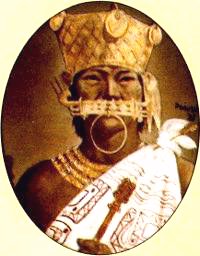
Bogotá was cacique of Chía and following the Muisca heritage rules, he as nephew of the previous ruler Nemequene succeeded his uncle in 1514. At the start of his reign, Bogotá fought against the Panche in the west of the Muisca Confederation. The brother of Tisquesusa and later -according to Muisca heritage rule illegal- successor Sagipa was the general in the southern Muisca army. Early on in his reign Tisquesusa went to war with the northern Muisca ruled by Quemuenchatocha. Forty thousands guecha warriors of the southern Muisca fought against fifty thousand northern Muisca. Earlier, support of the iraca Sugamuxi of the Iraca Valley helped the northern troops in their battles, but this time the third party helped settling a truce between both parties which lasted until the arrival of the Spanish conquistadores in 1537.
The Spanish conquest
Main article: Spanish conquest of the MuiscaThe arrival of the Spanish conquerors was revealed to Bogotá by the mohan Popón, from the village of Ubaque. He told the Muisca ruler that foreigners were coming and Tisquesusa would die "bathing in his own blood". When Tisquesusa was informed of the advancing invasion of the Spanish soldiers, he sent a spy to Suesca to find out more about their army strength, weapons and with how many warriors they could be beaten. The psihipqua left the capital Muyquytá and took shelter in Nemocón which directed the Spanish troops to there, during this march attacked by more than 600 Muisca warriors.
When Tisquesusa retreated in his fortified place in Cajicá he allegedly told his men he would not be able to combat against the strong Spanish army in possession of weapons that produced "thunder and lightning". He chose to return to Bacatá and ordered the capital to be evacuated, resulting in an abandoned site when the Spanish arrived. In search for the Muisca ruler the conquistadores went north to find Tisquesusa in the surroundings of Facatativá where they attacked him at night.
Alonso Domínguez, one of De Quesada's soldiers, thrust his sword at Tisquesusa, but without knowing he was the zipa, he let him go after taking the expensive mantle of the ruler. Tisquesusa fled hurt into the mountains and died of his wounds there. His body was only discovered a year later because of the black vultures circling over it.
At the death of Tisquesusa, his son Hama and daughter Machinza hid the sister of the psihipqua, Usaca, in one of the settlements on the Bogotá savanna. When one of the conquistadors, Juan María Cortés, found out about this, he prepared a battle to gain control over the area. At that moment, Usaca appeared and resisted against the Spanish conqueror. Legend tells that he dropped his weapons and fell in love with her, eventually marrying the sister of Tisquesusa and they were baptised in Usaquén, meaning "Land of the Sun" in Muysccubun. This formed the start of the construction of a colonial village, today part of the capital and known for its colonial architecture and parks.
Succession to the throne
Contrary to Muisca tradition, where the eldest son of the oldest sister of the previous ruler would become the next zipa, the reign was taken over by Tisquesusa's brother; his army general Sagipa. This would be the last ruler of the southern Muisca, defeated in 1538 and died of Spanish torture in early 1539.
Tisquesusa in Muisca history
| History of the Muisca | |||||||||

| |||||||||
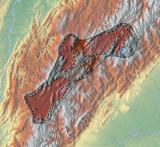 Altiplano |
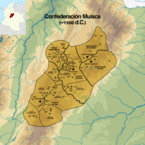 Muisca |
 Art |
 Architecture |
 Astronomy |
 Cuisine |
 El Dorado |
 Subsistence |
 Women |
 Conquest |
Modern historical revisionism
In investigations in the 21st century about the existence of Tisquesusa, doubt has been cast on his name. The name Tisquesusa originates from the work Elegías de varones ilustres de Indias written by poet Juan de Castellanos decades after the events of the conquest. In his work he names Tisquesusa as the zipa, while other researchers, such as Jorge Gamboa Mendoza, maintain the name was "Bogotá". Later scholars, such as Pedro Simón simply took the names from earlier sources without verifying them.
See also
Notes
- According to most sources the name "Bogotá" didn't exist in Muisca times, yet was a modification of Muyquytá, the name of the area where the psihipqua resided; on the Bogotá savanna
References
- (in Spanish) Biography Tisquesusa Archived 2016-06-11 at the Wayback Machine - Universidad Distrital Francisco José de Caldas
- (in Spanish) Tisquesusa would die bathing in his own blood - Pueblos Originarios
- (in Spanish) Zipa Tisquesusa - Banco de la República
- (in Spanish) Las tierras de la princesa Usaca - El Tiempo
- Jiménez Herrera, Juan Sebastián (2014), ¿Existió o no el cacique Tisquesusa? (in Spanish), El Espectador, retrieved 2016-09-29
Further reading
- Jiménez de Quesada, Gonzalo (1576), Memoria de los descubridores, que entraron conmigo a descubrir y conquistar el Reino de Granada (in Spanish), retrieved 2016-07-08
- De Castellanos, Juan (1857) , Elegías de varones ilustres de Indias (in Spanish), pp. 1–567, retrieved 2016-07-08
- Simón, Pedro (1892) , Noticias historiales de las conquistas de Tierra Firme en las Indias occidentales (1882-92) vol.1-5 (in Spanish), retrieved 2016-07-08
- Rodríguez Freyle, Juan; Achury Valenzuela, Darío (1979) , El Carnero - Conquista i descubrimiento del nuevo reino de Granada de las Indias Occidentales del mar oceano, i fundacion de la ciudad de Santa Fe de Bogota (PDF) (in Spanish), Fundacion Biblioteca Ayacuch, pp. 1–598, retrieved 2016-11-21
- Fernández de Piedrahita, Lucas (1688), Historia general de las conquistas del Nuevo Reino de Granada (in Spanish), retrieved 2016-07-08
- Caro Molina, Fernando (1967), Epítome de la Conquista del Nuevo Reino de Granada - Reseña (PDF), Cervantes Institute, pp. 116–130, retrieved 2016-12-21
- Friede, Juan (1960), Descubrimiento del Nuevo Reino de Granada y Fundación de Bogotá (1536-1539), Banco de la República, pp. 1–342, retrieved 2016-12-26
- Millán de Benavides, Carmen (2014), "Epítome de la conquista del Nuevo Reino de Granada", Universitas Humanística, 48 (48), Pontifical Xavierian University: 11–17, ISSN 2011-2734, retrieved 2016-12-21
- Millán de Benavides, Carmen (2001), Epítome de la conquista del Nuevo Reino de Granada la cosmografía española del siglo XVI y el conocimiento por cuestionario, Centro Editorial Javeriano, pp. 1–139, ISBN 9586833682, retrieved 2016-12-21
- Ramos Pérez, Demetrio (1972), Ximénez de Quesada en su relación con los cronistas: y el Epítome de la conquista del Nuevo Reino de Granada, CSIC, pp. 1–329, ISBN 9788400020774, retrieved 2016-12-21
- "Epítome de la conquista del Nuevo Reino de Granada", Boletín Cultural y Bibliográfico, 16 (3), Banco de la República: 81–97, 1979 , retrieved 2016-12-21
- Acosta, Joaquín (1848), Compendio histórico del descubrimiento y colonización de la Nueva Granada en el siglo décimo sexto [Historical overview of discovery and colonization of New Granada in the sixteenth century], Paris: Beau Press, pp. 1–460, OCLC 23030434, retrieved 2016-07-08
- Correa, François (2005), "El imperio muisca: invención de la historia y colonialidad del poder - The Muisca empire: invention of history and power colonialisation", Muiscas: representaciones, cartografías y etnopolíticas de la memoria (in Spanish), Universidad La Javeriana, pp. 201–226, ISBN 958-683-643-6
- Gamboa Mendoza, Jorge (2006), Los caciques en la legislación indiana: una reflexión sobre la condición jurídica de las autoridades indígenas en el siglo XVI - The caciques in the indian legislation: a review about the juridical condition of the indigenous authorities in the 16th century (PDF) (in Spanish), pp. 1–38, retrieved 2016-07-08
- Groot de Mahecha, Ana María (2014) , Sal y poder en el altiplano de Bogotá, 1537-1640 (in Spanish), Universidad Nacional de Colombia, pp. 1–174, ISBN 978-958-719-046-5
- Langebaek Rueda, Carl Henrik (2005), Muiscas: representaciones, cartografías y etnopolíticas de la memoria - The Muisca: representations, cartography and ethnopolitics (in Spanish), Universidad Javeriana, pp. 1–380, ISBN 958-683-643-6
- Langebaek Rueda, Carl Henrik (2005a), La élite no siempre piensa lo mismo [The elite does not always think the same] (in Spanish), Universidad La Javeriana, pp. 180–199, ISBN 958-683-643-6
- Langebaek Rueda, Carl Henrik; Bernal, Marcela; Aristizabal, Lucero; Corcione, María Antonieta; Rojas, Camilo; Santa, Tatiana (2011), "Condiciones de vida y jerarquías sociales en el norte de Suramérica: el caso de la población muisca en Tibanica, Soacha - Life conditions and social hierarchies in the north of South America: the case of the Muisca population in Tibanica, Soacha", Indiana (in Spanish), 28, Ibero-Amerikanisches Institut Preußischer Kulturbesitz: 15–34
- Martínez Martín, Abel Fernando, Entre risas y llantos. Una mirada a las costumbres muiscas a través de los cronistas - Between laughter and cry. A look at the Muisca habits through the chroniclers (in Spanish), pp. 1–16
- Salcedo Salcedo, Jaime (2011), "Un vestigio del cercado del señor de Bogotá en la traza de Santafe - A trace of the enclosure of the lord of Bogotá in the design of Santafe", Ensayos. Historia y teoría del arte (in Spanish), 20, Universidad Nacional de Colombia: 155–190
- Trimborn, Hermann (2005), "La organización del poder público en las culturas soberanas de los chibchas - The public power organisation in the common cultures of the Chibchas", Muiscas: representaciones, cartografías y etnopolíticas de la memoria (in Spanish), Universidad La Javeriana, pp. 298–314, ISBN 958-683-643-6
- Londoño, Eduardo (1989), Santuarios, santillos, tunjos: objetos votivos de los Muiscas en el siglo XVI (in Spanish), pp. 92–120
- Bonilla Romero, Julio H.; Bustos Velazco, Edier H.; Reyes Duvan, Jaime (2017), "Arqueoastronomía, alineaciones solares de solsticios y equinoccios en Bogotá-Bacatá - Archaeoastronomy, alignment solar from solstices and equinoxes in Bogota-Bacatá", Revista Científica, Universidad Distrital Francisco José de Caldas, 27: 146–155, retrieved 2016-12-26
- Bonilla Romero, Julio H. (2011), "Aproximaciones al observatorio solar de Bacatá-Bogotá-Colombia - Approaches to solar observatory Bacatá-Bogotá-Colombia", Azimut, Universidad Distrital Francisco José de Caldas, 3: 9–15, retrieved 2016-12-26
- Francis, John Michael (1993), "Muchas hipas, no minas" The Muiscas, a merchant society: Spanish misconceptions and demographic change (M.A.) (M.A.), University of Alberta, pp. 1–118
- Kruschek, Michael H. (2003), The evolution of the Bogotá chiefdom: A household view (PhD) (PDF) (PhD), University of Pittsburgh, pp. 1–271, retrieved 2016-07-08
- Correa Rubio, François (2005), "Sociedad y naturaleza en la mitología Muisca - Society and nature in the Muisca mythology", Tábula Rasa (in Spanish), 5, Bogotá, Colombia: 197–222, doi:10.25058/20112742.235, ISSN 1794-2489
- García Giraldo, Alfredo (2012) , Érase una vez entre los chibchas - Once upon a time between the Muisca (in Spanish), Bogotá, Colombia: Panamericana Editorial, pp. 1–116, ISBN 978-958-30-0298-4
- Ocampo López, Javier (2007), Grandes culturas indígenas de América - Great indigenous cultures of the Americas (in Spanish), Bogotá, Colombia: Plaza & Janes Editores Colombia S.A., pp. 1–238, ISBN 978-958-14-0368-4
External links
- (in Spanish) Animated video about Tisquesusa
| Muisca | ||||||||||||||||||||||||||||
|---|---|---|---|---|---|---|---|---|---|---|---|---|---|---|---|---|---|---|---|---|---|---|---|---|---|---|---|---|
| ||||||||||||||||||||||||||||
| ||||||||||||||||||||||||||||
| ||||||||||||||||||||||||||||
| ||||||||||||||||||||||||||||
| ||||||||||||||||||||||||||||
| ||||||||||||||||||||||||||||
